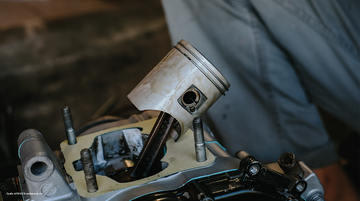
Funktion
Die im Kraftstoff gebundene Energie wird im Zylinder während des Arbeitstakts in Wärme und Druck umgesetzt. Dabei steigen die Wärme- und Druckwerte in kurzer Zeit sehr stark an. Dem Kolben als bewegliches Bauteil des Brennraums fällt die Aufgabe zu, einen Teil der dieser Energie in mechanische Arbeit umzuwandeln.
In seiner Grundform ist der Kolben ein einseitig geschlossener Hohlzylinder mit den Bereichen Kolbenboden mit Ringpartie, Kolbennabe und Schaft. Der Kolbenboden überträgt über die Kolbennabe, den Kolbenbolzen und die Pleuelstange die bei der Verbrennung des Kraftstoff-Luft-Gemischs entstehenden Druckkräfte auf die Kurbelwelle.
Anforderungen
Folgende Anforderungen müssen Kolben erfüllen:
- Anpassungsfähigkeit an Betriebsbedingungen
- Fresssicherheit bei gleichzeitig hoher Laufruhe
- Geringes Gewicht bei ausreichender Festigkeit
- Möglichst geringe Reibverluste
Die zum Teil gegenläufigen Anforderungen sowohl an die Konstruktion als auch da den Werkstoff, erfordern Maßnahmen die für den Einzelfall sehr unterschiedlich ausfallen können.
Gestaltung
Aufgrund der Betriebsanforderungen haben sich in der Regel Aluminium-Silizium-Legierungen als Kolbenwerkstoff durchgesetzt.
Funktionsbereiche beim Kolben sind der Kolbenboden, die Ringpartie mit dem Feuersteg, die Kolbennabe und der Kolbenschaft. Zur baugruppe der Kolben zählen auch noch die Kolbenringe, der Kolbenbolzen und die Kolbenclips.
Um die Massen gering zu halten, ist eine sorgfältige konstruktive Auslegung der Kolben notwendig.
Kolbenform
Der Kolben dehnt und verformt sich unter Einwirkung der Gastemperatur und der Kräfte, insbesondere der Gaskraft. Diese Formänderung gilt es bei der konstruktiven Gestaltung des Kolbens miteinzubeziehen, um einen klemmfreien Lauf bei Betriebstemperatur zu gewährleisten.
Üblicherweise haben Kolben in Kolbenbolzenrichtung einen geringfügig kleineren Durchmesser als in Druck-Gegendruck-Richtung. Die Differenz ist die Ovalität.
Am oberen und am unteren Ende wird der Kolben etwas eingezogen, um die Ausbildung des tragenden Schmierölkeils zu begünstigen. Der Stärkere Einzug im Bereich der Kolbenringpartie trägt zum einen der starken Wärmedehnung aufgrund hoher Temperaturen in diesem Bereich und der Verformung durch die Gaskraft Rechnung. Der Kolben wird daher ballig.
Die endgültige Kolbengestalt ist nur durch umfangreiche Simulationen und Motorenversuche abzusichern.
